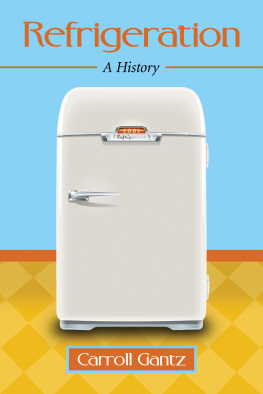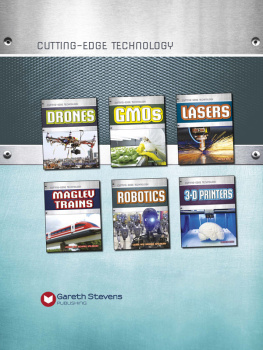
Also by CARROLL GANTZ
AND FROM MCFARLAND
Founders of American Industrial Design (2014)
The Vacuum Cleaner: A History (2012)
The Industrialization of Design: A History from the Steam Age to Today (2011)
Refrigeration
A History
Carroll Gantz

McFarland & Company, Inc., Publishers
Jefferson, North Carolina
LIBRARY OF CONGRESS CATALOGUING DATA ARE AVAILABLE
BRITISH LIBRARY CATALOGUING DATA ARE AVAILABLE
e-ISBN: 978-1-4766-1969-9
2015 Carroll Gantz. All rights reserved
No part of this book may be reproduced or transmitted in any form or by any means, electronic or mechanical, including photocopying or recording, or by any information storage and retrieval system, without permission in writing from the publisher.
Front cover image 2015 iStock/Thinkstock
McFarland & Company, Inc., Publishers
Box 611, Jefferson, North Carolina 28640
www.mcfarlandpub.com
This book is dedicated to the many scientists who discovered the principles of refrigeration, the practical engineers and entrepreneurs who designed and built the early machines to produce artificial ice and refrigeration, and the designers who transformed unattractive mechanical products into fashionable and user-friendly modern home appliances.
Acknowledgments
I would like to acknowledge a number of people who have made this book possible. The history of refrigeration is scattered in a number of corporate and history websites, often in fragmented, rather than complete form. The only comprehensive book on the subject I found was a 1994 book published by the American Society of Heating, Refrigerating, and Air Conditioning Engineers (ASHRAE) with the title Heat and Cold. It covers both heating and refrigeration history in depth. Its authors are quite knowledgeable about the subject, and I am indebted to them for considerable references to their text and illustrations in this book. For those who would like to know more about heating and cooling history, I highly recommend it. However, Heat and Cold ends in about 1930, before household refrigerators became common; this book continues the story of refrigeration to the present day, and includes the complete design history of common household refrigerators.
I was fortunate to be helped by my very good friend and design historian colleague, Victoria Matranga, H/IDSA, who provided images of 1950s refrigerators and the unusual icyball. Victoria is design projects coordinator and historian for the International Housewares Association (IHA) in Chicago and organizes IHA juries for annual student design competitions. She also curates many historical houseware exhibits for a number of museums, design firms, and private organizations. On her own time and at her own cost, she interviews aging industrial designers and surviving family members of those who have passed, in order to document industrial design history.
Another colleague, Hampton Wayt, an accomplished design historian and fine arts dealer, graciously provided me with rare images of a 1930 Westinghouse prototype rotating refrigerator concept, and of late 1930 Westinghouse products. Hampton is a dedicated researcher who has acquired the personal records of Donald Dohner, prominent designer and educator of the 1930s, credited by the Industrial Society of America (IDSA) as the father of industrial design education.
IDSA, the single national organization of the profession, generously granted me permission to use images from its publications and those of former organizations, depicting refrigerator designs of the 1950s and 1960s. Thanks to Karen Beruba, Senior Creative Director, and Daniel Martinage, IDSA Executive Director. In 1965, IDSA was formed from the merger of three industrial design organizations: the American Society of Industrial Designers, the Industrial Designers Institute, and the Industrial Design Education Association.
Chris Hunter, director of miSci, the Museum of Innovation and Science in Schenectady, New York, formerly the Schenectady Museum, was kind enough to give me permission to use a number of images from the museums extensive General Electric archives. General Electric was instrumental in the development of the first successful domestic refrigerator in 1927.
My son-in-law, Robert E. Schott, of Cranford, New Jersey, is an active practitioner of snow sculpture in his front yard when winter snows come, and has provided me with an example of his handiwork to illustrate how ordinary snowmen can evolve into artistic celebrations of natural snow. His 92-year-old father, Joseph Schott, provided his painting of a typical window card still used in the 1940s to order block ice from the local iceman. I am also grateful to Jimmy Scichilone for information regarding the 1953 Philco V handle refrigerator.
Preface
Not long ago, my 16-year-old refrigerator had a problem with its automatic ice-maker, and although it was easily repaired, it reminded me that I hadnt thought much about my refrigerator since I bought it. In human years, my trusty refrigerator would be about 80 years old, so I was appropriately impressed with its unfailing service, much more reliable than my washing machine, dryer, or dishwasher, which barely make it to middle age. Only stoves seem to survive refrigerators.
Not that I am an authority in the secret lives of appliances, but I have designed enough of them in my day to know that they are much more than just the metal, plastic, and nuts and bolts that hold them together: they are the physical representation of human ideas, human engineering, human manufacturing, and human design. As such, I have learned to regard their individual histories as stories of human vision, experimentation, and triumph over nearly insurmountable odds. This book is as much about the humans who contributed to the technology as about the technology itself.
Introduction
Many of us take our electric refrigerators and freezers for granted because few of us can recall being without one. But before 1922, only 5,000 homes in the entire United States had an electric refrigerator. Most other homes still had what were then called iceboxes, which had to be replenished with natural ice blocks delivered to the door by husky icemen, a regular domestic service that had become common since the mid1850s, over 70 years earlier.
In our modern age, when technology provides us all with scores of conveniences for easier living, instant communication, unlimited travel, and continuous entertainment, it is easy to forget, or never know, the long struggle over centuries, by countless scientists, engineers, and designers, that made each of these products possible. More recent technologies such as iPhones and iPads seem to be developed in a matter of a few years, only because they are simple incremental improvements in a mature personal computer technology that has evolved and been refined over the last 40 years. In the case of refrigerators, it was 210 years ago that the concept of mechanically produced, artificial refrigeration was first imagined. For centuries before that, the human desire to remain comfortably cool in the hottest climates, to cool drinking water, and to preserve perishable foods resulted in numerous discoveries of natural cooling principles and the clever use of natural snow and ice. These discoveries ultimately led to scientific and mechanical principles that duplicated nature in the production of artificial cold.
Next page








